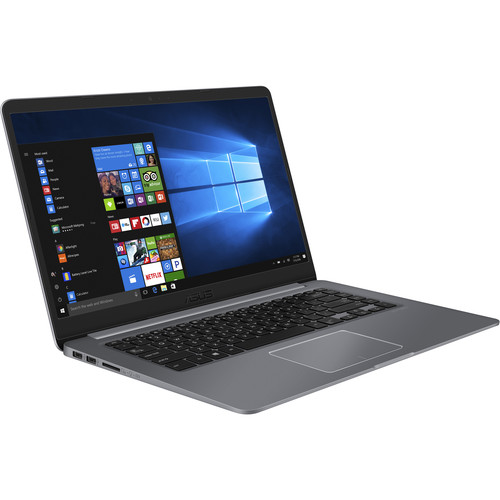Description
ASUS UX550VE-DB71T overview
The 15.6″ ZenBook Pro UX550VE Multi-Touch Notebook from Asus is a thin and light system, yet packs powerful hardware for more than just everyday use. It’s equipped with a 2.8 GHz Intel Core i7-7700HQ quad-core processor, 16GB of DDR4 RAM, and an NVIDIA GeForce GTX 1050 Ti graphics card with 4GB of GDDR5 VRAM. When handling a demanding task, the CPU can reach a core clock speed of 3.8 GHz. Thanks to its dedicated GPU, you’ll be able to play graphically demanding games even though this laptop doesn’t look like your average gaming system.
Its 15.6″ display features a 1920 x 1080 Full HD resolution and supports 10-point multi-touch so you can utilize touch gestures and commands within Windows 10. For storage, it has a 512GB NVMe PCIe SSD, which provides you with quick boot and load times compared to a standard hard drive. If you need more room, you can attach external storage devices using its multiple USB ports or its microSD card reader. Other integrated features include a webcam, a backlit keyboard, microphones, speakers, an HDMI port, Thunderbolt 3 ports, and a combo audio in/out jack. The operating system installed is Windows 10 Home (64-Bit).
Stylish, Thin, and Lightweight
The ZenBook Pro is made with a solid aluminum body, measuring only 0.74″ thin and weighing in at roughly four pounds so you can easily take it with you wherever you go.
NVIDIA GeForce GTX 10-Series Graphics Cards
NVIDIA’s GeForce GTX 10-series graphics cards can deliver up to a 40% increase in performance over the previous generation. Not only are they powerful, they can deliver similar performance to their desktop counterparts with a slight performance difference. This changes mobile gaming, allowing you to max out your game’s visuals settings so you can enjoy it at its best.
Less Heat, More Power
Equipped with dual fans and three heat pipes, the ZenBook Pro is engineered to stay cool for maximum performance without throttling.
NanoEdge Touchscreen
The NanoEdge display on this laptop measures roughly 0.3″ thin for a more immersive viewing experience. It also supports 10-point multi-touch so you can utilize touch gestures and commands to enhance its efficiency and accessibility.
Harman Kardon Audio
The speakers on this laptop are designed and optimized by the Asus Golden Ear team and Harman Kardon specialists to deliver wider frequency response and louder audio without distortion.
Thunderbolt 3
Thunderbolt 3 is a hardware interface that utilizes the reversible USB Type-C connector. Doubling the speed of its predecessor, Thunderbolt 3 features a maximum throughput of 40 Gb/s when used with compatible devices. The connector also transmits data via USB 3.1 at up to 10 Gb/s, and dual-bandwidth DisplayPort 1.2 allows you to connect up to two 4K displays simultaneously. Additionally, you can daisy chain up to six devices from a single Thunderbolt 3 port.
All Day Battery
The 73 Wh lithium-polymer battery is rated to last up to 14 hours of use. Moreover, when you need to get going, it can charge up to 60% capacity in just 49 minutes.
Keyboard and Touchpad
The ZenBook Pro features a full-sized silver-backlit keyboard with a 1.5 mm key travel so you can have a comfortable typing experience, even in dimly lit environments. Meanwhile, the touchpad features palm-rejection technology and supports multi-touch gestures and writing.
Fingerprint Sensor
Thanks to the built-in fingerprint sensor and webcam, you’ll be able to use Windows Hello technology to easily access your computer with just a touch or glance.
Windows 10 Home
After its hiatus in Windows 8, the Start Menu has returned. Utilizing a combination of the traditional menu system and Windows 8’s Live Tiles, the improved Start Menu gives you more information at a glance, showing notification information alongside your applications and other pinned items.
Cortana
Microsoft’s digital personal assistant, Cortana can answer your questions with information gleaned from both your device and the internet at large. You can type or even talk with her, if your system has a microphone. Using her Notebook, Cortana keeps track of your needs and wants, and she learns over time to improve her information gathering skills.
Microsoft Edge
After nearly 20 years, Microsoft has finally replaced its Internet Explorer web browser. With Microsoft Edge, users can write directly on web pages and share notes with friends and colleagues. It also improves the online reading experience by adding a distraction-free mode and read-it-later functionality. Edge also has built-in Cortana integration; you can have her help you find a restaurant, make a reservation, and pull up directions without leaving your browser.
Windows Store
For Windows 10, Microsoft has unified the Windows Store. Now, apps for PCs, tablets, and phones will all be accessible from one place. And with support for Universal Apps, one version of an app can work across all your compatible devices automatically.
Windows Continuum
Windows 10 was designed for a variety of screen sizes and input styles, and with its Continuum feature, it automatically adapts to fit your needs. A Windows 10 tablet on its own requires a touch-centric approach, but attaching a mouse and keyboard will shift everything to a more traditional interface. You can even attach an external monitor to your Windows 10 phone for a near-desktop experience. But it’s not just the operating system; Windows Universal Apps take advantage of Continuum as well.
Xbox on Windows 10
Gaming is a big focus of Windows 10. Xbox integration allows for PC players to match up against Xbox One players on supported games, and if you have an Xbox One, you can even stream compatible titles to your PC. Native support for recording with the new Game DVR feature makes it easy to capture and share your gameplay. The new DirectX12 takes better advantage of multi-core processors, giving games a performance boost, even on older hardware. Windows 10 also features native support for virtual reality headsets, such as the Oculus Rift.

















